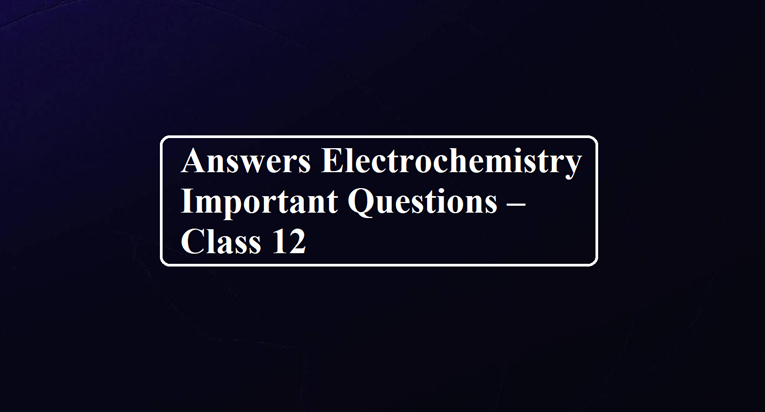Chapter Electrochemistry Test Paper – 1
Chapter Electrochemistry Test Paper
Que 1. Calculate the volume of gas liberated at anode at NTP from the electrolysis of CuSO4 solution by a current of 2 amperes passed for 10 minutes.
(A) 0.0696 litre
(B) 0.0211 litre
(C) 0.0727 litre
(D) 0.5312 litre
Que 2. The conductivity of a solution may be directly proportional to the total concentration of the charge carriers (ions) present in it in many cases. Find the percent decreases in conductivity (k) of a weak monoacidic base BOH solution when its 0.1 M solution is diluted to double its original volume. (Kb = 10–5 for BOH) (take = 7.07)
(A) – 20.12%
(B) – 29.29%
(C) – 17.12%
(D) – 35.13%
Que 3. Any redox reaction would occur spontaneously, if
(A) the cell emf is positive
(B) the free energy change (ΔG°) is positive
(C) the ΔG is positive
(D) the cell emf (E°) is negative
Que 4. Acidified water is electrolysed using an inert electrode. The volume of gases liberated at STP is 0.168L. The quantity of charge passed through the acidified water would be
(A) 96,500C
(B) 9,650C
(C) 965C
(D) 168C
Que 5. The type of electrode Pb | PbSO4(s) | H2SO4 used in acid storage cell is
(A) Metal electrode
(B) Non-metal electrode
(C) Metal-insoluble salt-anion electrode
(D) Oxidation-reduction electrode
Que 6. The following behaves as S.H.E. at a pressure Pt, H2 | H2O
(A) 1 atm
(B) 10–7 atm
(C) 107 atm
(D) 10–14 atm
Que 7. Electrode potential of the metals in their respective solution are provided. Arrange the metals in their increasing order of reducing power. K+/K = – 2.93V, Ag+/Ag = + 0.80V, Hg+/Hg = +0.79V, Mg2+/Mg = – 2.37V, Cr3+/Cr = –0.74V
(A) Ag < Hg < Cr < Mg < K
(B) Ag > Hg > Cr > Mg > K
(C) Mg < Hg < Cr < Ag < K
(D) Ag < K < Cr < Mg < Hg
Chapter Electrochemistry Test Paper
Que 8. The reaction Zn2+ + 2e– → Zn has a standard potential of – 0.76 V. This means
(A) Zn can’t replace hydrogen from acids
(B) Zn is reducing agent
(C) Zn is an oxidising agent
(D) Zn2+ is a reducing agent
Que 9. What is the value of pKb (CH3COO–) if λ0m= 390 & λm = 7.8 for 0.04 of a CH3COOH at 25ºC.
(A) 9.3
(B) 9.2
(C) 4.7
(D) 4.8
Que 12. Which statement is true about the spontaneous cell reaction in galvanic cell
(A) Eºcell > 0; ΔGº < 0 ; Quotient Q < Kc
(B) Eºcell > 0; ΔGº > 0 ; Q < Kc
(C) Eºcell > 0; ΔGº > 0 ; Q > c
(D) Eºcell > –; ΔGº > 0 ; Q < Kc
Que 11. An electric current is applied to an aqueous solution of FeCl2 and ZnCl2. Which reaction occurs at the cathode?
(A) Fe2+(aq) + 2e–(aq) → Fe(s) E°red = – 0.44V
(B) Fe(s) → Fe2+ (aq) + 2e– E°ox = 0.44V
(C) Zn+2(aq) + 2e–(aq) → Zn(s) E°red = – 0.76V
(D) Zn(s) → Zn2+ (aq) + 2e– E°ox = 0.76V
Que 12. Which statement is not true regarding the relationship of the free-energy change and the cell potential of a galvanic cell?
(A) When the cell potential is used to determine the free-energy change, the energy in joules is obtained.
(B) If the free-energy change indicates a spontaneous reaction, the cell potential has a negative value.
(C) The free-energy change and the cell potential of a galvanic cell are quantitative measures of the driving force of a chemical reaction.
(D) Both the free-energy change and the cell potential depend on the composition of the reaction mixture.
Que 13. Which is not a characteristic of the standard hydrogen electrode?
(A) The E° is 0 V.
(B) The concentration of H+ is 1 M.
(C) The temperature is 298 K.
(D) This oxidation half-reaction
2H+(aq) + 2e– → H2(g) ; 2H+(aq) takes place at the SHE electrode.
Que 14. If the standard potential for the galvanic cell
Ba(s) | Ba2+(aq) || Zn2+(aq) Zn(s) is 1.14 V, then what is the standard oxidation potential for the Ba/Ba2+ half-cell? (E° for Zn2+/Zn half-cell = – 0.76 V.)
(A) –1.90 V
(B) –1.5 V
(C) 0.38 V
(D) 1.90 V
Que 15. Calculate the maximum work that can be obtained from the Daniell cell given below –
Zn (s) | Zn2+ (aq) || Cu2+ (aq) | Cu (s). Given that = – 0.76 V and = + 0.34 V
(A) – 212300 J
(B) – 202100 J
(C) – 513100 J
(D) – 232120 J
Chapter Electrochemistry Test Paper
Que 16. A half cell is prepared by dipping an Ag electrode in a solution containing KCl and some AgCl. The half cell is used as a cathode during the cell reaction. The quantity of AgCl will
(A) Decrease
(B) Increase
(C) Remain the same
(D) Cannot say
Que 17. Which of the following is not true?
The conductivity of solutions of different electrolytes in the same solvent and at a given temperature differs due to:
(A) Size of the ions in which they dissociate
(B) Concentration of ions
(C) Charge of the ions in which they dissociate
(D) Is independent of ions movement under a potential gradient
Que 18. What will happen during the electrolysis of an aqueous solution of CuSO4 in the presence of Cu electrodes?
(A) Copper will deposit at the cathode
(B) Copper will dissolve at the anode
(C) Oxygen will be released at the anode
(D) Copper will deposit at the anode
Que 19. Which of the following statements is not correct?
(A) Copper liberates hydrogen from acids.
(B) In its higher oxidation states, manganese forms stable compounds with oxygen and fluorine.
(C) Mn3+ and Co3+ are oxidising agents in an aqueous solution.
(D) Ti2+ and Cr2+ are reducing agents in an aqueous solution.
Que 20. Which of the following statement is correct?
(A) ECell and ΔrG of cell reaction both extensive properties.
(B) ECell and ΔrG of cell reaction are both intensive properties.
(C) ECell is an intensive property while ΔrG of cell reaction is an extensive property.
(D) ECell is an extensive property while ΔrG of cell reaction is an intensive property.
Chapter Electrochemistry Test Paper
Chemistry Class 12 Chapter Solution Test Paper – 2
Chapter Solutions Test Paper – 1



